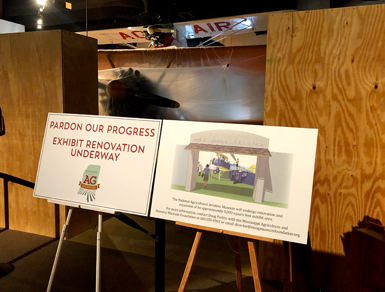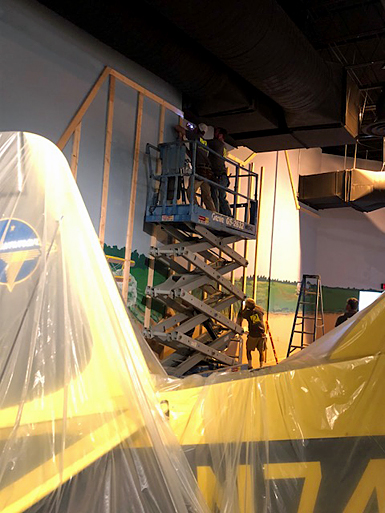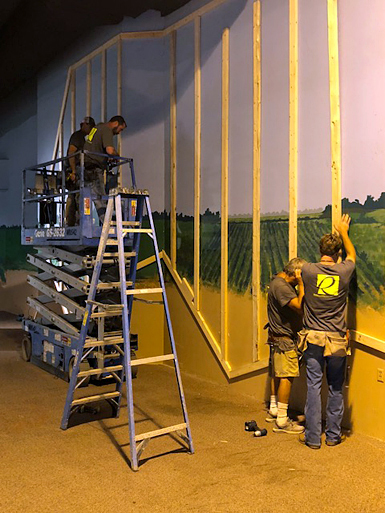After a lengthy planning
process, the National Agricultural Aviation Museum renovation campaign has
shifted into action mode. Phase one of several planned upgrades kicked off in mid-September, starting with the installation of new entrance and exit facades to the
Jackson, Miss.-based museum.

Construction signs indicating renovations at the National Agricultural Aviation Museum
The first phase of
renovations is expected to be completed by the end of September, paving the way
for more enhancements when the second phase of renovations begins. Those
upgrades will get underway once the Mississippi Agriculture & Forestry
Museum Foundation secures enough funds to complete the estimated $240,000
renovation project. The foundation is nearly $100,000 away from achieving full
funding.
The National Agricultural
Aviation Museum and Hall of Fame is housed inside the main gallery of the
Mississippi Agriculture and Forestry Museum in Jackson, Miss. The
4,500-square-foot exhibit was developed in 1983 to educate the public on the
importance of aerial application and the advancements within the agricultural
aviation industry. The current renovation project will result in a complete
overhaul of that space.
To learn more about the
project, NAAA interviewed Aaron Rodgers and Doug Parkin, the executive
directors of the Mississippi Agriculture and Forestry Museum and the
Mississippi Agriculture and Forestry Museum Foundation, respectively. The
interview has been lightly edited for space and clarity.
NAAA: What is the
purpose of the National Agricultural Aviation Museum?
Aaron Rodgers:The purpose
of the National Ag Aviation Museum is to present the past, the present and the
future of ag aviation to generations that have experienced the beginnings of it
as well as future generations to potentially inspire their potential career
opportunities.
NAAA: Where do your
visitors come from and how many visitors does the museum get?
Rodgers: We’ve
had as many as 140,000 visitors at the Mississippi Agriculture & Forestry
Museum and National Ag Aviation Museum in a year. We have visitors from all
over the world. I think our country count right now is over 30. And all over
the United States. We get a lot of school groups from Mississippi but also
school groups from neighboring states that come through. Last year we had over
20,000 18 and younger with school groups, with homeschool groups, with the
clubs and things like that, coming through the museum.
NAAA: Renovating the National Agricultural
Aviation Museum has been in the planning stages for a while, and now it’s starting
to happen. What are these renovations going to do for the NAA Museum in your
view?
Rodgers: I
think anytime that you can take something that was designed 40 years ago and
give it a big facelift and work on retelling the narrative of what it means,
you’re going to reconnect with a different audience. Or you’re going to connect
with a different audience and potentially reconnect with people that may have
seen it a handful of times. So it’s something that we really look forward to
promoting. We think that the promotion that we do is going to get a lot of new
visitors to come in and a lot of visitors that have been here a handful of
times to also realize that we’re making some changes, that we’re interested in
progressing as a museum. We believe that the ag industry in all of its forms
also progresses and that we need to be at the forefront of demonstrating that.

Renovations underway inside the National Agricultural Aviation Museum
NAAA: Have you considered developing or making
you current exhibit portable or mobile in any way so that it could be showcased
at other aviation museums or other agricultural museums around the country to
help promote the benefits of agricultural aviation, possibly as part of a
reciprocal sharing agreement if other museums had exhibits they could share?
Rodgers: We
absolutely have thought about that. And that’s something that we can do.
Museums do loan each other exhibits all the time. We’re working on the
renovation of the space first and making sure that we really nail both the look
and the historic narrative, the narrative of the future, the Hall of Fame going
forward. Then we’re looking at ways that we can develop some traveling exhibits
that hopefully will go out all over the United States, potentially the world.
That’s something that we’d absolutely love to see.
Doug Parkin: There’s
two challenges that come to mind for me right off the top. And one is that's
extremely expensive. We definitely have to get past this renovation and then
continue getting the funding to do that. Because I don’t see a [portable
exhibit] as a profit centered item. I tend to see it as an expense to do that.
The other thing is that you have to consider what you’re going to be able to
take because it’s a tremendous amount of wear and tear on pieces. Loading them
and unloading them and setting them up for display when they were on a truck. You
have to give a lot of consideration to the practicality of doing something. We’ve
had a lot of conversations about it, but that is still going to be an in-the-future
item.
NAAA: Getting back
to the current renovations, you’ve been working with your architectural and
engineering firm, Cooke Douglass Farr Lemons. Were there
any major takeaways that struck you from their analysis in terms of what the museum
has going for it already and what it could or should be going forward?
Rodgers: I
think whenever you have the opportunity to look at something from a new
perspective, it really could open your eyes to the possibilities of what’s
there. What we’ve done in the past here at the museum is that it just always
existed in a certain way. And it was really great to have some people that
weren’t associated with the museum come in and say, “Hey, you know, you can
view these planes from a different way. You can tell this story in a different
way. You can use this wall here to really make the whole thing feel very different
than what you had before.” And that’s the stuff that I’m just so enjoying
watching right now. It already feels different one weekend into the renovation.
NAAA: What do the NAA Museum and museums in
general need to do to stay relevant in the 21st century?
Parkin: Like
Aaron was saying, I think you just have to look at it a different way—find
something more exciting to do, find a better way to tell the story of the
individual features and maybe even narrow it down. Don’t just overwhelm people
with number of things in the museum but with the quality and the expression of
the story.
NAAA: A simulator has been cited as something
that would be a great “want to have” addition to the NAA Museum, but that’s not
an easy thing to acquire. What do you think that would add to the experience?
Parkin:I
think that something will happen on that. There are two conversations going on,
two different tracks of how that might happen. If we were to buy it outright,
everybody knows that the cost is extremely high, so it would equal a huge
portion of just the renovation itself. We need to find a means of reducing that
cost. We don’t need a full-scale real-life simulator; we need something that
will get a kid in the air and give them an experience of excitement that somewhat
resembles flying a crop duster. But it would give them some sense of that
excitement and bring the whole exhibit to life. Once they get in something like
that and have a hands-on experience, then I think they’ll see everything else
from a different perspective.
NAAA: Can you talk
about where the National Agricultural Aviation Museum renovation project is at
now and what it is going to take to get it to the next level? We reported in
the last issue of Agricultural Aviation that
you were $100,000 away from fully funding the renovation project.
Parkin: Love
to. And the $100,000 mention is just—we were actually flabbergasted. We had had
some various quotes over the past two years, and when it came down to getting
somebody signed on, it was more expensive than we had planned for phase one, so
we shaved a couple of features back that made sense. We are building an
observation deck to allow people a different perspective on looking down into a
cockpit. And that would require an accessibility lift, a small, open-area elevator
basically. That’s also where we had hoped to plant the simulator. We pushed [the
timetable for] that platform back, and right now we’re focusing on the walls,
particularly the background wall behind the airplanes which will feature some
tremendous murals.… And then working on the carpets and getting those done.
That’s going to be neat because it’s got a built-in fade into the carpet, so it
will transition in colors from the pathway over to the exhibit area. And we’re
trying to create a more open atmosphere around the planes and features without
allowing direct access to them. Just trying to get people a little bit closer
in and different angles than what we’ve had before.
The
money is what limits everything. I mean, money cures all evils. It really does.
So, we’re trying to be very conscientious but at the same time to move forward
completely and get to where we want to be. Yes, we will definitely need
additional funding. When we receive memorials and gifts, I try to point out to people
that at some point after we finish this renovation they can come by and see it
and feel very comfortable and confident in the fact that their donation made a
difference in the improvements that we’ve made. They participated in it.
NAAA: How would you describe the link between
NAAA and the National Agricultural Aviation Museum?
Parkin: From
my perspective at the Foundation, it’s really been great because I’ve been able
to get over and meet with them and present the story and build consensus
between the Foundation and the NAAA—to understand that we really want to help
tell that story of agricultural aviation in a meaningful way and step it up. Forty
years ago what we had was great, but it’s just time to freshen it up.
NAAA: What are your plans for the National
Agricultural Aviation Hall of Fame housed within the NAA Museum?
Rodgers: One
of the things that we find, with that Hall of Fame and a lot of other Hall of
Fames, is that sometimes the information presented is really specific to
industry. A lot of laypeople that know about those industries, oftentimes ...
we’ll gloss over it a little bit, as it’s just a little too technical. What we’re
looking to do with the new Hall of Fame is put it into a timeline which anyone
could understand. Certainly, present those Hall of Fame members and their
contributions individually in that but show someone who might not have a
background in ag aviation not just what they were doing but why it was
important. And doing that in a chronological way. I think the neat thing about
that is it’s going to give future members, people that are in flying school
right now or engineering school or may not even be born yet a path to look down
and say, “You know what? I can be on this wall. This is something that I can do
because I can solve this problem in aviation or this problem in agriculture.”
NAAA: What are some
of the things that will go into phase two of the renovation?
Rodgers: The
Hall of Fame will be redone, the historic narrative’s going to be redone. And
I’d really like to add some sections that touch on the importance of aerial
application in modern agriculture—21st century agriculture and feeding the
world. And just how far agriculture has come in terms of production and how
instrumental aerial application is into those massive increases in production.
Parkin: Some
of the other aspects will be some very nice artifact display cases that will
get things up and a little bit more visible. Put them on a kid’s eyeball level.
And then, of course, the viewing platform with the new perspective on viewing
down into the planes. Or at least into one of them. Having that accessibility
factor in the lift and in, again, the simulator. Trying to focus our lighting
to highlight features.
NAAA: Any parting thoughts?
Rodgers: We’re
excited to be going to the convention in Reno again this year. I’ve just
had such a good time meeting so many of the pilots, meeting industry leaders,
meeting allied industry leaders. And we really look forward to presenting this
first phase of this renovation and talking with them about making sure that the
second phase happens sooner rather than later.
Parkin: I
really appreciate the interest and support that everybody’s had in moving
forward on this. I appreciate the various state associations, too, that have
come forward with some donations to us. That means a lot. And just the general
attitude of everybody that, “Hey, yes, this thing is happening. It’s real.” We’ve
talked about it long enough. We’re thrilled that we’ve got that consensus to
move forward and it’s actually happening right this minute. That’s cool.

Renovations underway inside the National Agricultural Aviation Museum
To contribute to the National Agricultural Aviation Museum Renovation
Campaign, visit msagmuseumfoundation.org/support and click the “NAAM
Donation” button to designate your donation to the NAAM Renovation Campaign.
Donation checks may be mailed to: Mississippi
Agriculture and Forestry Museum Foundation, NAAM Renovation Campaign, Attn:
Doug Parkin, Executive Director, P.O. Box 55621, Jackson, MS 39296.